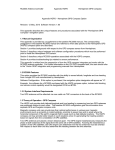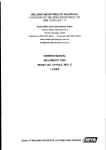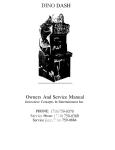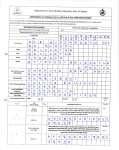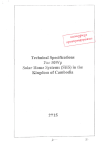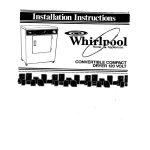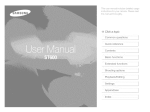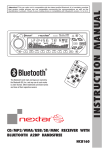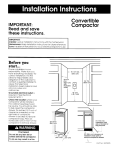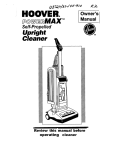Download Meade ETX User's Manual
Transcript
Meade Instruments Corporation 6001 OAK CANYON, IRVINE, CALIFORNIA 92620-4205 n (949) 451-l 450 FAX: (949) 451-1460 n www.meade.com Operating Instructions Meade@ ETX Field Tripod For Use With the ETX Astro Telescope b. Attaching the Accessory Tray: Remove the round accessory tray (6), Fig. 1, from the shipping box. Remove the black, star-shaped lock knob from the threaded rod on the bottom of the accessory tray. Attach the tray to the tripod by inserting the threaded rod through the central hub of the extension strut (7) Fig. 1. Rethread the lock knob onto the accessory tray. Varying the Tripod Height: Loosen the black, star-shaped height adjustment knob (5) Fig. 1, at the base of each tripod leg. Slide the three top tripod leg sections to the desired height. Tighten the three height adjustment knobs, (5) Fig. 1, to a “firm feel”. Do not overtighten. Collapsing the Tripod for Storage: Remove the accessory tray (6), Fig. 1, from the tripod. Grasp the top of the tripod wrth one hand, and with the other hand, pull up on the central hub of the extension strut (7) Fig. 1, where the accessory tray was attached. This action will cause the tripod legs to move inward to a collapsed position. Important Notes on using ETX Field Tripod: . Remove the accessory tray before attempting to collapse the tripod. . If the tripod does not extend or collapse easily, do not force the tripod legs in or out. By following the above instructions the tripod will function properly. Forcing the tripod into an incorrect position may damage the extension strut system. . Do not overtighten the three star-shaped height adjustment knobs on the tripod legs. “Firm feel” tightening is sufficient. L Fig. 1: ETX Field Tripod. (1) Mounting Slots; (2) Mounting Plate; (3) Latijude Scale; (4) Fine Latitude Adjustment Knob; (5) Height Adjustment Knob; (6) Accessory Tray; (7) Extension Strut System; (6) North-Pointing Tripod Leg (marked “N” at position of arrow); 19) Fine Azimuth Adjustment Knobs; (10) Latitude Lock Knob: (11) Latitude Lock Lever (opposite side). 2. Attaching the ETX Astro Telescope to the Tripod PARTS LISTING AND ASSEMBLY a. Confirm that the latitude lock lever (11) Fig. 1, is in the locked posltlon by rotating the lever clockwlse untrl trght. Also confrrm that the N/S swatch on the base of the E T X Astro Telescope IS set for the correct hemsphere b. In the side of the ETX drive base, locate the two attachment holes, Fig. 2. (These holes are normally used with the fixed legs of the table tripod.) Position the ETX on the Field Tripod so that the “N” When opening the packing box for the first time, note carefully the following parts included with the ETX Field Tripod: - Tripod - 2 Attachment Knobs - Accessory Tray . 1. Preparing the Tripod For Use The ETX Field Tripod (Fig. 1) is simple to set up and easy to use. Users need only attach the accessory tray and adjust the tripod to the desrred observtng hetght. a. Extending the Tripod: Remove the tripod from the shtpptng box and stand it upright. Grasp two of the tripod legs, leaving the full weight of the tripod on the third leg. Gently pull the legs apart to a full open posltion. Fig. 2: ETX Drove Base, showmg attachment holes. . C. Then, align the two holes in the base of the ETX with the mounting slots (1) Fig. 1, on the mount plate (2) Fig. 1. d. Thread the two provided l/4-20 threaded attachment knobs through the mounting slots into the ETX base. Tighten to a firm feel only. Do not overtighten or damage to the threads may occur. The ETX Astro Telescope can be used for land or celestial To track celestial objects, polar alignment is observing. required, along with the motor drive system of the ETX. (See the Motor Drive section of the ETX instruction manual.) POLAR ALIGNMENT Polar alignment is the process of lining up the telescope’s polar axis with the North Celestial Pole (or South Celestial Pole if observing from the southern hemisphere). Note: By following the procedures listed above, the ETX telescope is polar aligned for most celestial observing applications. See Figure 3. Approximate polar alignment is sufficient in the great majority of these applications. Do not allow a time-consuming effort at precise polar alignment to interfere wifh your basic enjoyment of the telescope, as such precise alignment is, in general, not reqtiired. Using the North Star, Polaris, to find North aids in the polar alignment procedure. Polaris can be found in relation to the Big Dipper by projecting a line from the so-called “pointer stars” of the Big Dipper. For southern hemisphere alignment, locate south by using the faint star Sigma Octans (the South Star) With a polar aligned ETX, tracking celestial objects is possible simply by turning on the drive motor in the base of the telescope. The motor counteracts Earth’s rotation, keeping objects in the field of view. Also, with a polar aligned telescope, the ETX’s Dee and R.A. setting circles may be used to locate faint objects directly from their catalogued coordinates. 0 *...__b *...“’ Cassiopeia Fig. 4: Locating Polaris. 2. Using a Polar Aligned Telescope Once the telescope is polar aligned, the ETX motor drive will keep a celestial object in the field of view of the telescope. a. To center a celestial object within a polar aligned telescope, unlock the Dee and R.A. lock levers of the telescope (see the Locating Astronomical Objects section of the ETX instruction manual). Do not move the tripod or adjust the latitude angle when centering an object in the telescope, as this will destroy the polar alignment. b. Once a celestial object has been centered in the telescope, lock the Dee and R.A. lock levers. C. Locate the On/Off switch on the bottom of the ETX drive base and turn on the motor drive. The motor drive will keep the celestial object within the telescope’s field of view. Fig. 3. (left) The ETX Astro Telescope on Field Tripod. ownted for land wewIng. (right) The polar-allgned ETX, ready for astronomlcal wewng. 1. Polar Alignment Procedures Make sure the ETX is firmly attached to the tripod, as described above In this tnstruction sheet, with latitude lock knob (10) and the latitude lock lever (11) Fig 1. firmly locked Step (a) below IS equrvalent to pointing the telescope’s polar axls due north (or due south for observers in the southern hemisphere). Step (b) IS equrvalent to makrng the telescope’s latitude angle equal to the latitude angle of your obset-vmg location. a. b. . On top of one of the tripod legs, locate the letter “N” (8) Fig. 1. This represents the north leg of the tnpod. Prck up the entire telescope-and-tripod and onent the tripod u tf@ lea marked “N” points due north. For observers In the southern hemisphere (e.g., Australra), the lea marked “N” should pornt due south. Determine the latitude of your observing locatron by checking a road map, atlas, or refer to pages 12-13 of the ETX manual. To set the latitude of the tripod to your obseN!ng location, loosen the latitude lock knob (lo), Fig. 1. Turn the fine latitude adjustment knob (4) Fig. 1, clockwise or counterclockwise until the latitude pointer Indicates the correct latitude on the latitude scale (3) Fig. 1. It may be necessary to loosen the lock nut on the fine latitude adjustment knob (4) Fig. 1, to allow enough movement of the mount to achieve the latitude of your location. Once the desrred latitude has been set, tighten the lock nut until it is flush agamst the mount. Trghten the latitude lock knob (lo), Fig. 1, as well. . Note: The fine azimuth adjustment knobs (9), Fig. 7, which move the telescope horizontally without moving the tripod itself, may be used to aId m the alignment procedure. Note: Depending on the accuracy of the alignment procedure, it may be necessary to use the R.A. and Dee Slow Motion Controls to make minor adjustments to keep the celestial object in the field of view. d. The motor drive disengages when the R.A. and Dee lock levers are unlocked and re-engages when the lock levers are locked, making it possible for the motor drive to remain on during the entire observing session. e. At the end of an observing session, remember to turn off the motor drive. 3. Terrestrial Use of the Field Tripod In land viewing applications, the three legs of the Field Tripod may be posrtioned In an arbitrary orientation. The telescope mounting, however, should be placed in a horizontal positron: (Fig. 3) by turning the fine latitude adjustment knob (4) Frg. 1, to read 90”, unlocking and re-lockrng the latitude lock knob‘(lO), Fig. 1, to accomplish this adjustment. The ETX’s motor drive Use the should be turned off In terrestnal applications. telescope’s R.A. and Dee slow-motion controls for fine motion in horizontal and vertical. If you have any questions regarding the use of the ETX Field Tripod, please call Meade Customer Service at (949) 451-1450. *


